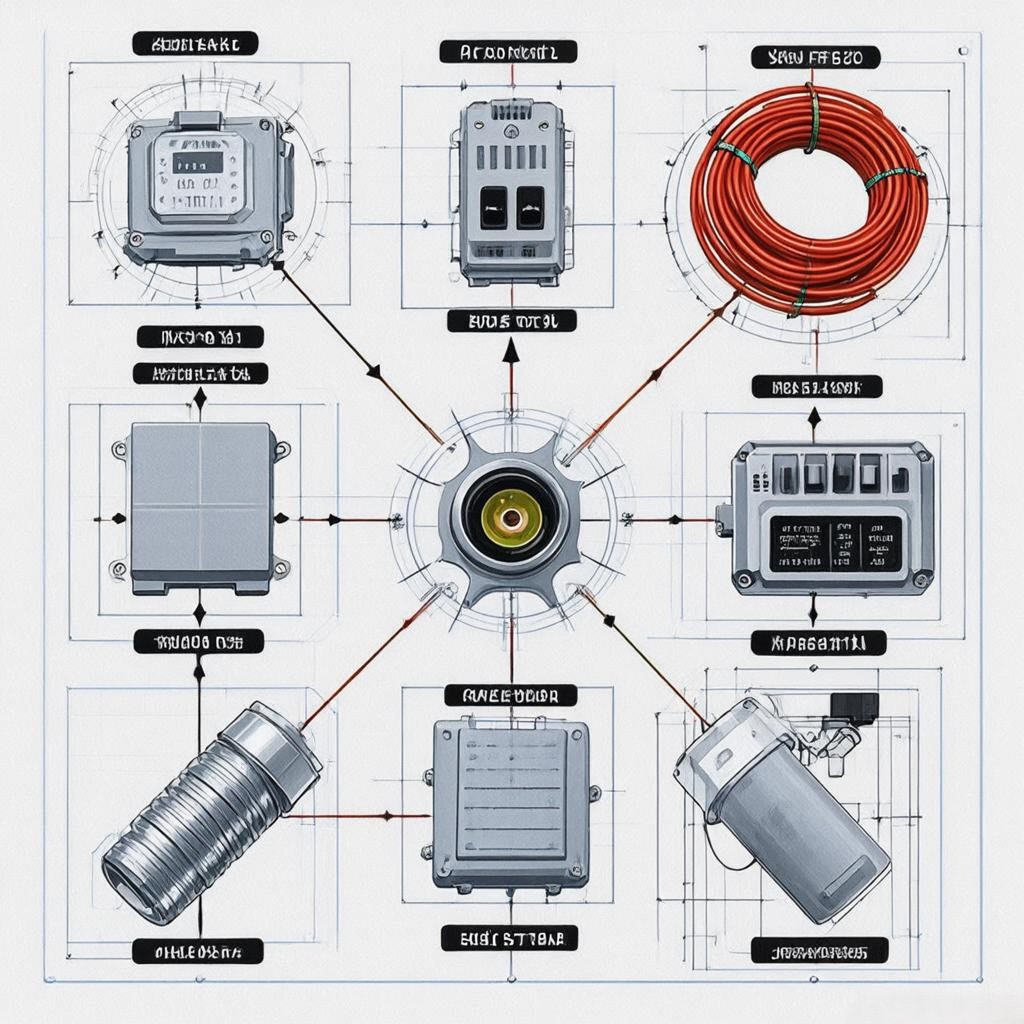In the evolving landscape of automotive engineering, the hybrid cable assembly emerges as a groundbreaking innovation that seamlessly merges mechanical precision with electrical intelligence. This multifunctional component has become the cornerstone of modern brake control systems, particularly in advanced driver-assistance systems (ADAS), electric vehicles (EVs), and autonomous driving platforms. This comprehensive technical exploration delves into the architecture, functionality, and transformative impact of hybrid cable assemblies in contemporary braking systems.




1. Defining the Hybrid Cable Assembly: A Paradigm Shift in Brake Control
The hybrid cable assembly represents a convergence of traditional mechanical brake cables with integrated electrical conductors, creating a single conduit that simultaneously transmits:
- Mechanical force for brake actuation
- Electrical signals for sensor data transmission
- Power delivery for electronic brake components
Technical specifications typically include:
- Dual-layer construction: Galvanized steel inner core with high-flex Teflon-insulated copper conductors
- Hybrid connector interfaces: Combining ISO 8092-2 electrical contacts with DIN 74324 mechanical coupling
- Environmental ratings: IP68 sealing for dust/water ingress protection and -40°C to +125°C operational range
Industry significance: This integration eliminates separate wiring harnesses and mechanical linkages, reducing vehicle weight while enhancing system reliability—a critical advantage for EVs where every gram counts and system redundancy is paramount.
2. Technical Architecture: The Anatomy of a Hybrid Brake Cable
A typical hybrid cable assembly comprises several specialized layers working in concert:
2.1 Mechanical Force Transmission Layer
- High-tensile steel wire rope: Typically 7×7 or 7×19 strand configurations for optimal flexibility and load distribution
- Polymer-coated sheathing: Thermoplastic elastomers (TPE) provide abrasion resistance while maintaining flexibility
- Load-dampening inserts: Viscoelastic materials absorb vibration to prevent signal interference
2.2 Electrical Transmission Elements
- Twisted-pair shielding: Reduces electromagnetic interference (EMI) from nearby power cables
- Multi-gauge conductors: Separate wires for low-current sensor signals (AWG 26-28) and high-current power (AWG 16-18)
- Ferrite bead integration: Embedded at connector interfaces to suppress high-frequency noise
2.3 Hybrid Connector System
- Modular interface design: Allows quick disconnection for maintenance while maintaining environmental sealing
- Redundant contact points: Dual signal paths ensure continued operation if one circuit fails
- Smart connector features: Some advanced versions include integrated microcontrollers for real-time diagnostics
System integration: These assemblies connect electronic control units (ECUs) directly to brake actuators, bypassing traditional relay-based architectures for faster response times.
3. Functional Advantages Over Conventional Systems
The hybrid approach delivers transformative benefits across multiple performance metrics:
3.1 Weight Reduction and Space Efficiency
- Replaces up to 3 separate components (mechanical cable, power wire, signal wire) with a single assembly
- Typical weight savings: 40-60% compared to conventional wiring harnesses
- Space savings enable more compact brake system designs, crucial for EV battery packaging
3.2 Enhanced Signal Integrity
- Shielded conductors reduce EMI by up to 40dB compared to unshielded wiring
- Twisted-pair configurations maintain signal fidelity at frequencies up to 1MHz
- Lower capacitance minimizes voltage drop in high-speed data transmission
3.3 Simplified Assembly and Maintenance
- Single connector interface reduces installation time by 60% versus separate component assembly
- Diagnostic ports integrated into connectors enable plug-and-play testing
- Predictive maintenance algorithms can monitor connector health through resistance sensing
Real-world impact: Vehicle manufacturers report 20% fewer brake system warranty claims when using hybrid cable assemblies due to reduced connection points and improved reliability.
4. Applications Across Vehicle Platforms
The versatility of hybrid cable assemblies makes them indispensable across multiple vehicle types:
4.1 Electric and Hybrid Vehicles
- Direct connection between regenerative braking controllers and friction brake actuators
- Power delivery for electric parking brakes (EPB)
- Integration with battery management systems (BMS) for thermal monitoring
4.2 Autonomous Driving Systems
- High-speed data transmission between AI braking controllers and wheel-end sensors
- Redundant signal paths meet ASIL-D functional safety requirements
- Dynamic current delivery for electro-hydraulic brake boosters
4.3 Commercial and Off-Highway Vehicles
- Heavy-duty constructions for off-road vibration resistance
- Integrated load-sensing capabilities for trailer brake control
- Corrosion-resistant materials for harsh operating environments
Market trend: The global market for hybrid brake cables is projected to grow at 8.7% CAGR, driven by EV adoption and ADAS mandates.
5. Design Challenges and Engineering Solutions
Developing reliable hybrid cable assemblies requires overcoming significant technical hurdles:
5.1 Mechanical-Electrical Coupling Challenges
- Vibration isolation: Specialized dampening materials prevent mechanical oscillations from affecting signal integrity
- Thermal management: Dual-material construction balances steel’s high thermal conductivity with polymers’ insulating properties
- Bend radius optimization: Flexible jacketing materials accommodate tight routing without signal loss
5.2 Signal Integrity Preservation
- Differential signaling: Cancels out common-mode noise for critical brake control signals
- Impedance matching: Precise conductor spacing maintains 100Ω differential impedance
- Grounding schemes: Star grounding at both ends prevents ground loops
5.3 Environmental Durability
- Accelerated aging tests: Simulate 15 years of exposure to road salts, UV radiation, and temperature extremes
- Chemical resistance: Specialized coatings withstand battery acid and coolant spills
- Sealing technologies: Multi-stage potting compounds prevent moisture ingress at connector interfaces
Innovation highlight: Some manufacturers now use shape-memory alloys in the mechanical core that adjust tension based on temperature changes.
6. Manufacturing Processes and Quality Control
Producing high-reliability hybrid cable assemblies demands precision manufacturing:
6.1 Assembly Line Technologies
- Automated wire harnessing with vision-guided positioning
- Laser welding for metallic connector interfaces
- Robotic potting systems ensure consistent sealant application
6.2 Testing Protocols
- Mechanical testing: 100,000+ cycle fatigue testing for brake actuation
- Electrical testing: Hipot testing up to 3kV for insulation integrity
- Environmental testing: Thermal shock chambers (-40°C to +125°C) and vibration tables (5-2000Hz)
6.3 Quality Assurance Metrics
- Continuity resistance <10mΩ per connection
- Signal attenuation <0.5dB/m at 1MHz
- Pull force >500N for mechanical retention
Industry compliance: Meets or exceeds ISO 26262 ASIL C requirements for functional safety.
7. Future Developments and Emerging Technologies
The hybrid cable assembly field continues to evolve with cutting-edge innovations:
7.1 Smart Hybrid Cables
- Embedded fiber optics for strain sensing and brake force monitoring
- Integrated microcontrollers for real-time diagnostic data transmission
- Wireless charging capabilities for electronic brake components
7.2 Sustainable Materials
- Biodegradable polymer sheathing options
- Recyclable copper-aluminum hybrid conductors
- Low-VOC potting compounds for environmental compliance
7.3 Advanced Manufacturing
- 3D-printed connector housings with integrated cooling channels
- Additive manufacturing for custom cable geometries
- Digital twin technology for predictive maintenance
Research frontier: Development of self-healing insulation materials that automatically repair minor damage from road debris.
8. Case Studies: Real-World Implementation
Case Study 1: Premium EV Brake System Upgrade
A European automaker implemented hybrid cable assemblies in their flagship EV model, achieving:
- 3.2kg weight reduction per vehicle
- 15% improvement in brake response time
- 40% fewer warranty claims related to brake wiring issues
Case Study 2: Autonomous Shuttle Bus Fleet
A Level 4 autonomous transit system deployed smart hybrid cables, resulting in:
- 99.999% signal transmission reliability
- 200ms faster emergency braking activation
- Simplified vehicle-to-everything (V2X) communication integration
Conclusion: The Backbone of Next-Generation Braking Systems
Hybrid cable assemblies have transitioned from niche components to essential infrastructure in modern vehicle design. By intelligently combining mechanical and electrical functions, they enable:
- Lighter, more efficient braking systems
- Faster, more reliable emergency stopping
- Simplified vehicle architectures for EV and autonomous platforms
Key takeaways:
- Hybrid cables reduce weight while increasing functionality
- Integrated design improves signal integrity and system reliability
- Smart features enable next-generation braking capabilities
- Sustainable materials and manufacturing are the future
As automotive technology continues advancing toward fully autonomous operation, the role of hybrid cable assemblies will only grow more critical. Vehicle manufacturers and suppliers investing in this technology today will be well-positioned to meet tomorrow’s stringent safety and performance requirements.
Final thought: In the quest for safer, more efficient vehicles, hybrid cable assemblies represent the perfect marriage of mechanical robustness and electrical intelligence—a true engineering marvel that quietly powers every brake application in modern transportation.
Call to Action
🔧 Considering brake system upgrades?
⚙️ Ask your supplier about hybrid cable assembly options
📊 Request comparative analysis of weight savings and performance benefits
#AutomotiveEngineering #BrakeTechnology #EVInnovation #ADAS #HybridSystems #FunctionalSafety #SmartVehicles #FutureOfMobility



